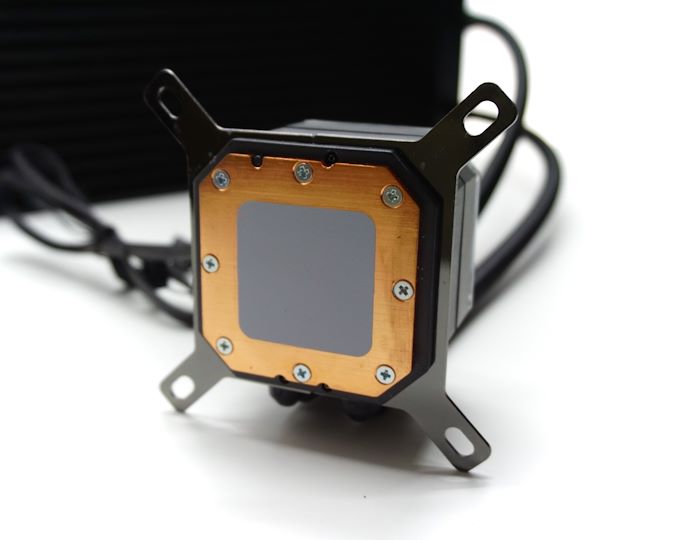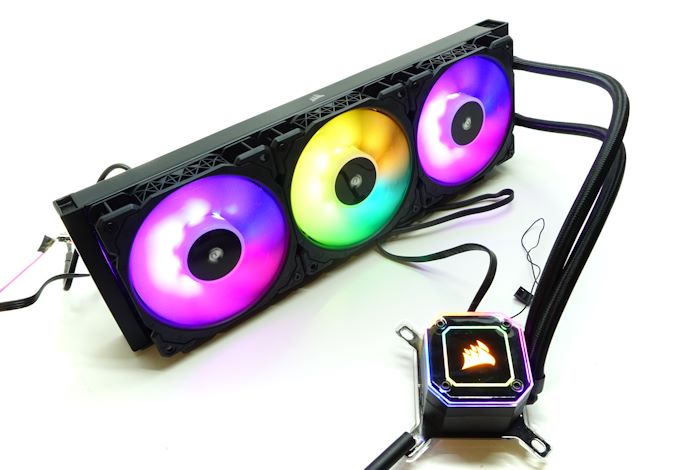The Corsair H150i Elite Capellix AIO Cooler Review: Go Big Or Go Home
by E. Fylladitakis on October 15, 2020 9:30 AM EST- Posted in
- Cases/Cooling/PSUs
- Corsair
- Water Cooling
- Liquid Cooling
- RGB
- iCUE
Conclusion
All-in-one CPU coolers first hit the market in force over a decade ago, which since then has allowed for more than enough time for developers to optimize their thermal performance, leaving little room for additional raw performance advancements. Nowadays, with many manufacturers retailing AIO cooler solutions, the market is pretty much saturated, a common outcome in the world of PC parts. Because of this, Corsair is always striving to maintain a competitive advantage by designing products with unique features, which is what made the release of the H150i Elite Capellix an anticipated move.
Where the H150i Elite Capellix has the lead over most of the competition is in terms of quality. Corsair ensured that their top AIO cooler is very well made, with excellent materials and a solid overall build quality. They also supply top-tier and fairly expensive MagLev cooling fans with the cooler, something that is often overlooked despite the fans being one of the most important parts of an AIO cooler.
The prime marketing feature of the H150i Elite Capellix is the included Commander CORE module and its compatibility with Corsair’s iCUE ecosystem. This opens up practically limitless user-programmable options, both aesthetic and practical. Except from the versatility that the iCUE software affords to the H150i Elite Capellix itself, it also enables greater control over other system fans and lights, allowing for system-wide lighting programming and sensory input. For example, it is easy to change the lighting of the cooler depending on which gaming profile is selected or for all compatible devices to share exactly the same lighting effect. The disadvantage of this feature is simple and obvious – this kind of total synergy only works with iCUE compatible devices, meaning that not even all of Corsair’s products are compatible with this feature.
However when it comes to performance, the H150i Elite Capellix barely any better than the H150i Pro RGB that the company released two years ago. We suspected as much from before we tested the cooler, as it is obvious that both coolers share the same radiator and tubing. The H150i Elite Capellix technically leads our thermal performance charts but the very powerful 2400 RPM fans are primarily responsible for this, which actually damage the cooler’s noise-to-performance ratio. Running the fans of the H150i Elite Capellix at the same speed as the fans of the H150i Pro RGB yields virtually the same performance, with but a tiny advantage for the H150i Elite Capellix – an advantage so small that can easily be a statistical error. Regardless, the quick fans provided with the H150i Elite Capellix offer greater versatility, as they can be programmed to stay quiet but also can be made loud if, for whatever reason, the user needs them to be.
Although the H150i Elite Capellix does not have a distinct performance advantage over the previous generation of cooler, its MSRP of $189 actually is reasonable and competitive. Despite the included Commander CORE, iCUE compatibility, and other minor upgrades, it's the same MSRP as the older H150i Pro RGB, making for a pleasant surprise as it means Corsair hasn't raised priced. In fact, it's generally priced close to – or even lower than – most of its direct competition. So from a performance standpoint, although Corsair hasn't managed to really move the needle on performance or pricing for their new cooler, the latest H150i is (still) just as competitive as the previous version.
Ultimately, this means that although we can't recommend the H150i Elite Capellix as an upgrade over a previous-generation cooler, Corsair continues to deliver a solid AIO cooler as far as new builds are concerned. The small quality of life improvements that come with newest H150i will help ensure that Corsair keep its advantage with unique features, all the while offering a better value to users that are considering a large AIO cooler today.













37 Comments
View All Comments
SirMaster - Sunday, October 25, 2020 - link
I mean my air cooled PC fans are never faster than 800rpm. I can't even tell if it's on or off from a few feet away.khanikun - Sunday, October 18, 2020 - link
A whisper is around 30 db. NZXT Kraken X63 280mm in reviews is around 30 db at low. So I'd say that's whisper quiet.willis936 - Thursday, October 15, 2020 - link
Not even Corsair's marketing speaks so highly about these fans. Magnetic bearings are not "magnetic levitation engines" (that would be the motor, which all fans have) and they are not new.They're awesome and they're cool to see in case fans, but the 1st page words leave a bad taste.
https://en.wikipedia.org/wiki/Magnetic_bearing
https://www.corsair.com/corsairmedia/sys_master/pr...
E.Fyll - Thursday, October 15, 2020 - link
From my point of view, the magnetic bearing is but a part of the engine that converts electrical energy to mechanical energy (airflow). You are probably referring to the engine as just the part that converts electrical energy to torque, neglecting the rest of the transmission system, which is not wrong but I would rather keep things simpler than that in my texts. I always classify fan engines based on their movement transmission system because everything else remains pretty much the same. You will find terms such as "ball-bearing engine" and "sleeve-bearing engine" frequently in my texts. The term "magnetic levitation engine" may not be entirely technically correct but definitely is better than "a 12V DC brushless motor with a magnetic levitation bearing axial transmission system" for the average person.Magnetic bearings may not be new by technological terms but they are just finding applications in low-cost retail market products, hence they are cutting-edge by the applicable definition of the term. There are many technologies that find their way into the retail market many decades after their initial discovery - that does not make them archaic, it only means that the conditions made their commercial exploitation applicable.
willis936 - Thursday, October 15, 2020 - link
These are fair points. Thanks for taking the time to respond.Pneumothorax - Thursday, October 15, 2020 - link
I’m currently running a NH-D15 on a 9900K. Am I getting any improvement with this besides just the aesthetics?Drkrieger01 - Thursday, October 15, 2020 - link
No. You'll may actually lose cooling capacity, as Linus found out (Linus Tech Tips). He did a review showing that big heatsinks like the Noctua NH-D15 outperform pretty much all AIO water coolers when it comes to heat soak (when the heatsink/radiator hit their dissipation limits). Granted, the margin is only a few degrees, but still. What you will get with an AIO water cooler is a slower increase/decrease in temperatures as the water works as an absorbing/transfer medium. The more water in the loop, the longer it takes to bring up the temperatures.Drkrieger01 - Thursday, October 15, 2020 - link
I should also say that, if AIO coolers would actually use a copper radiator, they would outperform something like the NH-D15. None of the AIO's use copper in their radiator, and I believe this is due to a patent being held by the main AIO manufacturer.imaheadcase - Thursday, October 15, 2020 - link
I don't think that would matter though, it still follows tubing back to the CPU, that itself is terrible at temp retention. Especially when they make them long on purpose for all case types they installed in.But yah i found its to much of a hassle to go all out with stuff like this, really AIO coolers for me now are just about looking better and working better in case for airflow than actual performance.
imaheadcase - Thursday, October 15, 2020 - link
on side note pet peeve, for whatever reason EVERY AIO cooler i have bought has never fit correctly in a case i've had..despite it showing it should before i bought it. Its mostly cosmetic things to change, like bending a small piece of metal, or something you won't notice with case cover on. But last one was a pain because after everything was installed in complete new build..it wouldn't power on. So did the normal check everything is connected, yep. I ended up finding out that radiator actually cut the USB cable connection front of case next to power button. So it was shorting out, all i had to do was unplug usb and booted up fine.That litte stupid problem would of been avoided if had correct specs..that was like 2 hours of trouble shooting. lol